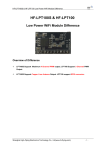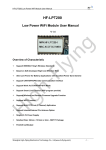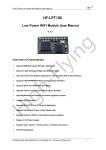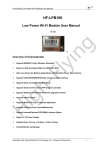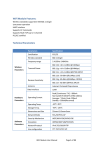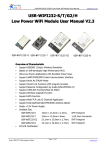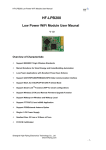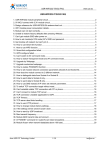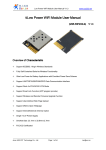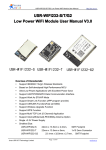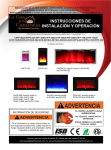Download HF-LPC100 Wi-Fi/Bluetooth Module User Manual
Transcript
HF-LPC100 Wi-Fi/Bluetooth Module User Manual HF-LPC100 Wi-Fi/Bluetooth Module User Manual ng V 1.0 yi Overview of Characteristic Support 802.11b/g Wireless Standard, STA Mode Support Bluetooth 2.1+EDR Standard Support Bluetooth SmartLink Cost Effective Solution With High-Flying MCU H ig h- Fl Support UART/GPIO Data Communication Interface Support Wireless/Remote Firmware Upgrade Provide SDK for Application develop Support Internal/External Antenna Option Smallest Size:23.1mm x 32.8mm x (3.45±0.3)mm Wide Input Voltage:3.3V~ 4.2V FCC/CE Certificated Shanghai High-Flying Electronics Technology Co., Ltd www.hi-flying.com -1- HF-LPC100 Wi-Fi/Bluetooth Module User Manual TABLE OF CONTENTS LIST OF FIGURES ...................................................................................................................................5 LIST OF TABLES ....................................................................................................................................6 HISTORY ..................................................................................................................................................7 PRODUCT OVERVIEW ...................................................................................................................8 General Description .................................................................................................................8 1.2. Device Features........................................................................................................................8 1.3. Device Parameters ...................................................................................................................9 1.4. Key Application ........................................................................................................................9 1.5. Hardware Introduction ...........................................................................................................10 Pin Definition .....................................................................................................................10 1.5.2. Electrical Characteristic ....................................................................................................12 1.5.3. Mechanical Size ................................................................................................................13 1.5.4. On-board Chip Antenna ....................................................................................................14 1.5.5. External Antenna ..............................................................................................................14 1.5.6. Evaluation Kit ....................................................................................................................15 1.5.7. Order Information ..............................................................................................................16 Typical Application ................................................................................................................17 1.6.1. 1.7. yi 1.5.1. 1.6. Hardware Typical Application ...........................................................................................17 Bluetooth Sonic Configuration .............................................................................................18 FUNCTION DESCRIPTION ...........................................................................................................19 H ig h- 2. ng 1.1. Fl 1. 3. 2.1. Wireless Networking ..............................................................................................................19 2.2. Work mode:Transparent Transmission Mode ..................................................................19 2.3. UART Frame Scheme ............................................................................................................20 2.3.1. UART Free-frame .............................................................................................................20 2.3.2. UART Auto-Frame ............................................................................................................20 2.4. Bluetooth Function ................................................................................................................21 2.5. Firmware Upgrade..................................................................................................................21 2.6. GPIO/PWM Function(TBD) ....................................................................................................23 2.7. Double SOCKET Communication Function ........................................................................23 AT INSTRUCTION INTRODUCTION ............................................................................................25 3.1. Configuration Mode ...............................................................................................................25 3.1.1. 3.2. Switch to Configuration Mode ...........................................................................................25 AT+ Instruction Set Overview ...............................................................................................26 3.2.1. Instruction Syntax format ..................................................................................................26 3.2.2. At+ Instruction set .............................................................................................................27 3.2.2.1. AT+E .............................................................................................................................29 3.2.2.2. AT+ENTM .....................................................................................................................30 3.2.2.3. AT+TMODE ...................................................................................................................30 3.2.2.4. AT+MID .........................................................................................................................30 3.2.2.5. AT+VER ........................................................................................................................30 Shanghai High-Flying Electronics Technology Co., Ltd www.hi-flying.com -2- HF-LPC100 Wi-Fi/Bluetooth Module User Manual 3.2.2.6. AT+LVER ......................................................................................................................31 3.2.2.7. AT+RELD ......................................................................................................................31 3.2.2.8. AT+FCLR ......................................................................................................................31 3.2.2.9. AT+Z..............................................................................................................................31 AT+H .........................................................................................................................31 3.2.2.11. AT+CFGRD ...............................................................................................................31 3.2.2.12. AT+CFGWR ..............................................................................................................32 3.2.2.13. AT+CFGFR ................................................................................................................32 3.2.2.15. AT+UART ..................................................................................................................32 3.2.2.16. AT+UARTF ................................................................................................................33 3.2.2.17. AT+UARTFT ..............................................................................................................33 3.2.2.18. AT+UARTFL ..............................................................................................................33 3.2.2.19. AT+UARTTE..............................................................................................................34 3.2.2.20. AT+SEND ..................................................................................................................34 3.2.2.21. AT+RECV ..................................................................................................................34 3.2.2.22. AT+PING ...................................................................................................................34 3.2.2.23. AT+NETP ..................................................................................................................35 3.2.2.24. AT+MAXSK ...............................................................................................................35 3.2.2.25. AT+TCPLK ................................................................................................................36 3.2.2.26. AT+TCPTO ................................................................................................................36 3.2.2.27. AT+TCPDIS ...............................................................................................................36 3.2.2.28. AT+SOCKB ...............................................................................................................37 3.2.2.29. AT+TCPDISB ............................................................................................................37 3.2.2.30. AT+TCPTOB .............................................................................................................38 3.2.2.31. AT+TCPLKB ..............................................................................................................38 3.2.2.32. AT+UDPLCPT ...........................................................................................................38 3.2.2.33. AT+SNDB ..................................................................................................................38 3.2.2.34. AT+RCVB ..................................................................................................................39 3.2.2.35. AT+WSSSID ..............................................................................................................39 3.2.2.36. AT+WSKEY ...............................................................................................................39 3.2.2.37. AT+WANN .................................................................................................................40 3.2.2.38. AT+WSMAC ..............................................................................................................40 3.2.2.39. AT+BTMAC ...............................................................................................................40 3.2.2.40. AT+WSLK ..................................................................................................................41 3.2.2.41. AT+WSLQ .................................................................................................................41 3.2.2.42. AT+WSCAN...............................................................................................................41 3.2.2.43. AT+WSDNS...............................................................................................................42 3.2.2.44. AT+UPURL ................................................................................................................42 3.2.2.45. AT+UPFILE ...............................................................................................................42 3.2.2.46. AT+LOGSW ...............................................................................................................42 3.2.2.47. AT+LOGPORT ..........................................................................................................43 3.2.2.48. AT+UPST ..................................................................................................................43 3.2.2.49. AT+MSLP ..................................................................................................................43 3.2.2.50. AT+NTPRF ................................................................................................................44 H ig h- Fl yi ng 3.2.2.10. Shanghai High-Flying Electronics Technology Co., Ltd www.hi-flying.com -3- HF-LPC100 Wi-Fi/Bluetooth Module User Manual AT+NTPEN ................................................................................................................44 3.2.2.52. AT+NTPTM................................................................................................................44 3.2.2.53. AT+NTPSER .............................................................................................................45 3.2.2.54. AT+WRMID ...............................................................................................................45 3.2.2.55. AT+RLDEN ................................................................................................................45 3.2.2.56. AT+ASWD .................................................................................................................45 3.2.2.57. AT+MDCH .................................................................................................................46 3.2.2.58. AT+TXPWR ...............................................................................................................46 3.2.2.59. AT+SMTLK ................................................................................................................46 3.2.2.60. AT+LPTIO ..................................................................................................................47 PACKGAE INFORMATION ...........................................................................................................48 ng 4. 3.2.2.51. 4.1. Recommend Reflow Profile ..................................................................................................48 4.2. Device Handling Instruction (Module IC SMT Preparation) ...............................................48 4.3. Shipping Information .............................................................................................................49 APEENDIX A: HARD REFERENCE DESIGN .................................................................................50 yi APPENDIX B: CONTROL GPIO、 PWM FUNCTION WITH NETWORK COMMAND(TBD) ....51 B.1 Network Command ....................................................................................................................51 B.2 Hexadecimal Network Command .............................................................................................54 Fl APPENDIX C: HTTP PROTOCOL TRANSFER ..............................................................................57 C.1. HTTP AT Command ..................................................................................................................57 AT+HTTPURL ...................................................................................................................57 C.1.2. AT+HTTPTP .....................................................................................................................57 C.1.3. AT+HTTPPH .....................................................................................................................57 C.1.4. AT+HTTPCN .....................................................................................................................58 C.1.5. AT+HTTPUA .....................................................................................................................58 C.1.6. AT+HTTPDT .....................................................................................................................58 H ig h- C.1.1. C.2. HTTP Example ...........................................................................................................................58 APPENDIX D: BLUETOOH ONE-KEY CONFIGURATION ...........................................................60 APPENDIX E: HF-LPX SERIES MODULE PIN COMPATIBLE TABLE ......................................64 APPENDIX F: CONTACT INFORMATION.......................................................................................65 Shanghai High-Flying Electronics Technology Co., Ltd www.hi-flying.com -4- HF-LPC100 Wi-Fi/Bluetooth Module User Manual LIST OF FIGURES Figure 1. HF-LPC100 View ..................................................................................................................10 Figure 2. HF-LPC100 Pins map ..........................................................................................................10 Figure 3. HF-LPC100 Mechanical Dimension .....................................................................................13 Figure 4. HF-LPC100 PCB symbol size ..............................................................................................13 Figure 5. HF-LPC100module placement region ..................................................................................14 Figure 6. HF-LPC100 Evaluation Kit(TBD) ..........................................................................................15 Figure 7. HF-LPC100 order information ..............................................................................................16 Figure 8. HF-LPC100 Figure 9. Basic HF-LPC100 wireless networking structure .................................................................19 ng hardware typical application ..........................................................................17 Double Socket setting view ...............................................................................................24 Figure 11. HF-LPC100 Default UART parameter ..............................................................................25 Figure 12. Switch to configuration mode ............................................................................................25 Figure 13. ‖AT+H‖ instruction for help ................................................................................................26 Figure 14. Reflow soldering profile ....................................................................................................48 Figure 15. Shipping information .........................................................................................................49 H ig h- Fl yi Figure 10. Shanghai High-Flying Electronics Technology Co., Ltd www.hi-flying.com -5- HF-LPC100 Wi-Fi/Bluetooth Module User Manual LIST OF TABLES HF-LPC100 Module Technical Specifications ........................................................................9 Table 2 HF-LPC100 Pins Definition ..................................................................................................10 Table 3 Electrical Characteristic ........................................................................................................12 Table 4 Power Supply & Power Consumption ..................................................................................12 Table 5 HF-LPC100 External Antenna Parameter ............................................................................14 Table 6 HF-LPC100 Evaluation kit interface description ...................................................................15 Table 8 HF-LPC100 GPIO/PWM Pin mapping table .........................................................................23 Table 10 Error Code Description .........................................................................................................27 Table 11 AT+ Instruction Set List ........................................................................................................27 Table 12 reflow soldering parameter ...................................................................................................48 H ig h- Fl yi ng Table 1 Shanghai High-Flying Electronics Technology Co., Ltd www.hi-flying.com -6- HF-LPC100 Wi-Fi/Bluetooth Module User Manual HISTORY 12-05-2014. First version H ig h- Fl yi ng V 1.0 Shanghai High-Flying Electronics Technology Co., Ltd www.hi-flying.com -7- HF-LPC100 Wi-Fi/Bluetooth Module User Manual 1. PRODUCT OVERVIEW 1.1. General Description HF-LPC100 is a embedded Wi-Fi /BT module ,which provide wireless interface to any equipment with a UART or other interface to data transmission. It integrated MAC, baseband processor, RF transceiver with power amplifier in hardware and Wi-Fi/BT protocol and configuration functionality and network TCP/IP stack, in embedded firmware to make a fully self-contained 802.11b/g Wi-Fi solution for a variety of applications. optimized for all kinds of clients ng HF-LPC100 employs the world‘s lowest power consumption embedded architecture. It has been application in the home automation smart grid, handheld device, personal medical application and industrial control that have lower data rates, and transmit or receive data on an infrequent basis. The HF-LPC100 integrates all Wi-Fi functionality into a low-profile, 23.1x32.8x (3.45±0.3)mm SMT yi module package that can be easily mounted on main PCB with application specific circuits. Also, module provides built-in antenna, external antenna option. 1.2. Device Features Support 802.11b/g Wireless Standard, STA Mode Support Bluetooth 2.1+EDR Standard Support SmartLink Function by Bluetooth(Provide IOS/Android APP Lib) Cost Effective Solution With High-Flying MCU H ig h- Fl Support UART/GPIO Data Communication Interface Support Wireless/Remote Firmware Upgrade Provide SDK for Application develop Support Internal/External Antenna Option Smallest Size:23.1mm x 32.8mm x (3.45±0.3)mm Wide Input Voltage:3.3V~ 4.2V FCC/CE Certificated Shanghai High-Flying Electronics Technology Co., Ltd www.hi-flying.com -8- HF-LPC100 Wi-Fi/Bluetooth Module User Manual 1.3. Device Parameters Table 1 Wireless Item Parameters Certification FCC/CE Wireless standard 802.11 b/g, 802.15.2 Frequency range 2.412GHz-2.484GHz 802.11b: +16 +/-2dBm (@11Mbps) Transmit Power 802.11g: +14 +/-2dBm (@54Mbps) Parameters 802.11b: -93 dBm (@11Mbps ,CCK) Receiver Sensitivity 802.11g: -85 dBm (@54Mbps, OFDM) External:I-PEX Connector Antenna Option Internal:On-board PCB antenna UART Data Interface SPI, PWM, GPIO Parameters Operating Current Operating Temp. Peak [Continuous TX]: ~220mA Average. ~30mA, Peak: 220mA -25℃- 85℃ -45℃- 125℃ Fl Storage Temp. 3.3~4.2V yi Operating Voltage Hardware ng Class HF-LPC100 Module Technical Specifications 23.1mm×32.8mm×(3.45±0.3)mm Network Type STA, BT2.1 Security Mechanisms WEP/WPA-PSK/WPA2-PSK Encryption WEP64/WEP128/TKIP/AES Update Firmware Local Wireless, Remote H ig h- Dimensions and Size Software Parameters Customization Network Protocol User Configuration Web Page Upgrade Support SDK for application develop IPv4, TCP/UDP/HTTP AT+instruction set. Android/ iOS Bluetooth Smart Link APP tools 1.4. Key Application Handheld device Personal medical Industrial control Remote monitor IOT application Industrial sensor and controller Portable wireless communication product. Consumer electronics Shanghai High-Flying Electronics Technology Co., Ltd www.hi-flying.com -9- HF-LPC100 Wi-Fi/Bluetooth Module User Manual 1.5. Hardware Introduction HF-LPC100 View Figure 1. H ig h- Fl yi ng 1.5.1. Pin Definition Figure 2. HF-LPC100 Pins map Table 2 HF-LPC100 Pins Definition Pin 1,17,32,48 2 Describtion Net Name Signal Type Ground GND Power Debug Pin SWCLK I, PD 3 NC 4 NC 5 Debug Pin SWD Shanghai High-Flying Electronics Technology Co., Ltd - Comments Debug functional pin, No connect if not use. I/O,PU www.hi-flying.com - 10 HF-LPC100 Wi-Fi/Bluetooth Module User Manual Pin Describtion Net Name Signal Type Comments 6 N.C No connect 7 N.C No connect 8 N.C No connect 9 +3.3V Power DVDD Power N.C No connect 11 N.C No connect 12 N.C No connect 13 N.C No connect 14 N.C No connect 15 N.C 16 N.C 18 N.C 19 N.C 20 N.C 22 Power Control Switch 24 No connect No connect No connect No connect N.C No connect N.C No connect PWM_SW (Function is reserved) I,PU N.C Fl 23 No connect yi 21 ng 10 No connect USB1.1 D+ USB_DP I/O GPIO25, No connect if not use. 26 USB1.1 D- USB_DM I/O GPIO26, No connect if not use. 27 GPIO GPIO27 I/O GPIO27, No connect if not use. H ig h- 25 28 N.C No connect 29 N.C No connect 30 GPIO/AD GPIO30 I/O 31 +3.3V Power DVDD Power 33 N.C GPIO30, No connect if not use. No connect 34 +3.3 Power DVDD Power 35 WPS Function WPS I/O GPIO35, No connect if not use. 36 N.C No connect 37 N.C No connect 38 N.C No connect 39 UART0 40 41 O N.C UART0 42 43 UART0_TX UART0_RX No connect I N.C Wi-Fi Status nLink GPIO39, No connect if not use. GPIO41, No connect if not use. No connect O "0"- Wi-Fi is connected "1"-Wi-Fi is not connected 44 Module Boot Up Indicator nReady O ―0‖ – Boot-up OK; ―1‖ – Boot-up No OK; Shanghai High-Flying Electronics Technology Co., Ltd - www.hi-flying.com - 11 HF-LPC100 Wi-Fi/Bluetooth Module User Manual Pin Describtion Net Name Signal Type Comments GPIO44,No connect if not use.; 45 Multi-Function nReload 46 I,PU N.C 47 Module Reset EXT_RESETn No connect I,PU ―Low‖ effective reset input. <Remark>: I — input;O — output 1.5.2. Electrical Characteristic Table 3 Parameter ng PU—pull up;PD—pull down; I/O: digital I/O; Power—power supply Electrical Characteristic Condition Typ. Max. Unit 125 °C 260 °C 0 3.8 V 0 3.3 V -45 Maximum soldering temperature Supply voltage Voltage on any I/O pin yi Storage temperature range Min. IPC/JEDEC J-STD-020 TAMB=25°C 2 KV ESD (Charged Device Model, CDM) TAMB=25°C 1 KV Power Supply & Power Consumption H ig h- Table 4 Fl ESD (Human Body Model HBM) Parameter Condition Operating Supply voltage Min. Typ. Max. Unit 2.8 3.3 3.8 V Supply current, peak Continuous Tx 220 mA Supply current, IEEE PS DTIM=100ms 30 mA Output high voltage Sourcing 6mA Output low voltage Sinking 6mA Input high voltage 2.8 V 0.2 2.2 V Input low voltage 0.8 GPIO Input pull-up resistor 200 GPIO Input pull-down resistor 200 Shanghai High-Flying Electronics Technology Co., Ltd - www.hi-flying.com V V kΩ kΩ - 12 HF-LPC100 Wi-Fi/Bluetooth Module User Manual 1.5.3. Mechanical Size Fl yi ng HF-LPC100 physical size (unit: mm)as below: Figure 3. HF-LPC100 Mechanical Dimension H ig h- HF-LPC100 module PCB symbol size (unit :mm) as below: Figure 4. HF-LPC100 PCB symbol size Shanghai High-Flying Electronics Technology Co., Ltd - www.hi-flying.com - 13 HF-LPC100 Wi-Fi/Bluetooth Module User Manual 1.5.4. On-board Chip Antenna HF-LPC100 module support internal on-board chip antenna option. When customer select internal antenna, you shall comply with following antenna design rules and module location suggestions: For customer PCB, RED color region (8.3x18.4mm) can‘t put component or paste GND net; Antenna must away from metal or high components at least 10mm; Antenna can‘t be shielded by any metal enclosure; All cover, include plastic, shall away from antenna at least 10mm Meanwhile please contact High Flying technique support to assist regarding module placement Fl yi ng and Layout design. Figure 5. 1.5.5. External Antenna module supports internal antenna and external antenna(I-PEX) option for user H ig h- HF-LPC100 HF-LPC100module placement region dedicated application. If user select external antenna, HF-LPC100 modules must be connected to the 2.4G antenna according to IEEE 802.11b/g/n standards. The antenna parameter required as table 5 Table 5 HF-LPC100 External Antenna Parameter Item Parameter Frequency 2.4~2.5GHz Impedance 50 Ohm VSWR 2 (Max) Return loss -10dB (Max) Connector type I-PEX or populate directly Shanghai High-Flying Electronics Technology Co., Ltd - www.hi-flying.com - 14 HF-LPC100 Wi-Fi/Bluetooth Module User Manual 1.5.6. Evaluation Kit High-Flying provides the evaluation kit to promote user to familiar the product and develop the detailed application. The evaluation kit shown as below, user can connect to HF-LPC100 module with the RS-232 UART, RS485, USB (Internal USB to UART convertor) or Wireless port to configure the parameters, manage the module or do the some functional tests. Evaluation kit HF-LPC100 Evaluation Kit(TBD) Fl Figure 6. yi ng support USB power supply and 5-18V DC input. <Notes>:User need download USB to UART port driver from High-Flying web or contact with technical support people for more detail. H ig h- The external interface description for evaluation kit see Table 6: Table 6 HF-LPC100 Evaluation kit interface description Function Name description External COM1 data/command interface JTAG Microphone JTAG data debug interface (not available for customer) MIC INPUT,used for Wi-Fi configuration or audio record Speaker Audio output interface (for speaker) USB USB1.1 data interface DC Jack DC 5~18V Input EXT PORT LED Power nLink HF-LPC100 GPIO function extend interface connector 3.3V power indicator nLink -Wi-Fi status indicator:(on-connected; offdisconnect) Shanghai High-Flying Electronics Technology Co., Ltd - RS-232 interface 1 www.hi-flying.com - 15 HF-LPC100 Wi-Fi/Bluetooth Module User Manual Function Name description nReady – module boot-up or upgrade ok on:module boot-up ok; nReady off:module boot-up failed; twinkle:remote upgrading, twinkle frequency and download speed is in direct proportion Button nReset Press the button over 3 seconds to restore factory setting ng nReload Reset button 1.5.7. Order Information Based on customer requirement, HF-LPC100 can support difference variants and physical H ig h- Fl yi type ,detail as below: Figure 7. HF-LPC100 order information Shanghai High-Flying Electronics Technology Co., Ltd - www.hi-flying.com - 16 HF-LPC100 Wi-Fi/Bluetooth Module User Manual 1.6. Typical Application Fl yi ng 1.6.1. Hardware Typical Application Figure 8. <Notes>: HF-LPC100 hardware typical application H ig h- nReset- module reset signal. Input, low level effective. There is pull-up resister internal and no external pull-up required. When module power up or some issue happened, MCU need assert nRST signal ―0‖ at least 10ms, then set‖ 1‖ to keep module fully reset. nLink- Module WIFI connection status indication. Output. (This pin is recommend to connect to LED, indicate status when the module in wireless upgrade mode) When module connects to AP (AP associated), this pin will output ―0‖. This signal used to judge if module already at WiFi connection status. Thers is pull-up resister internal and no external pull-up required. If nLink function not required, can leave this pin open. nReady- Module boot up ready signal. Output. Logics ―0‖ effective. The module will output ―0‖ after normal boot up. This signal used to judge if module finish boot up and ready for application or working at normal mode. If nReady function not required, can leave this pin open. nReload- Module restore to factory default configuration.Input. Logics ―0‖ effective. (This pin is recommend to connect to button, is used to enter wireless upgrade mode) Shanghai High-Flying Electronics Technology Co., Ltd - www.hi-flying.com - 17 HF-LPC100 Wi-Fi/Bluetooth Module User Manual User can de-assert nReload signal ―0‖ more than 3s through button or MCU pin, then release, module will restore to factory default configuration and re-start boot up process.. If nReload function not required, can leave this pin open. UART0_TXD/RXD-UART port data transmit and receive signal. 1.7. Bluetooth Sonic Configuration Sonic configuration is a Wi-Fi smart link method based on audio technology.(High Flying patent). By its natural advantage of audio transmit, Bluetooth enable module receive audio information sent compile the router‘s password and ID to audio ng from smart terminal. The APP on smart terminal signal and play it through Bluetooth. Then the Wi-Fi module with Bluetooth signal and realize the Wi-Fi connection. will analysis the audio Nowadays Bluetooth is the standard deployment on smart terminal. Since the good support to audio, this configuration has the minimum demand on smart terminals and greatly reduced the configure steps and instabilities, no matter it is Bluetooth 2.1, 3.0 or 4.0, or kinds of Android terminal, Iphone, Ipad . Any end users without technique background can quickly and easily H ig h- Fl yi realize the Wi-Fi connection to any routers with 100% success ratio. Shanghai High-Flying Electronics Technology Co., Ltd - www.hi-flying.com - 18 HF-LPC100 Wi-Fi/Bluetooth Module User Manual 2. FUNCTION DESCRIPTION 2.1. Wireless Networking Figure 9. Fl yi ng The wireless networking based on STA,user devices connect to router via LPC100. Basic HF-LPC100 wireless networking structure 2.2. Work mode:Transparent Transmission Mode H ig h- HF-LPC100 module support serial interface transparent transmission mode. The benefit of this mode is achieves a plug and play serial data port, and reduces user complexity furthest. In this mode, user should only configure the necessary parameters. After power on, module can automatically connect to the default wireless network and server. As in this mode, the module's serial port always work in the transparent transmission mode, so users only need to think of it as a virtual serial cable, and send and receive data as using a simple serial. In other words, the serial cable of users‘ original serial devices is directly replaced with the module; user devices can be easy for wireless data transmission without any changes. The transparent transmission mode can fully compatible with user‘s original software platform and reduce the software development effort for integrate wireless data transmission. The parameter which needs to configure include: Wireless network parameter Wireless network name(SSID) Security mode Encryption key Default TCP/UDP link parameter Protocol type Link type(server or Client) Shanghai High-Flying Electronics Technology Co., Ltd - www.hi-flying.com - 19 HF-LPC100 Wi-Fi/Bluetooth Module User Manual Target port ID number Target port IP address Serial port parameter Baud rate Data bit Parity (check) bit Stop bit Hardware flow control 2.3.1. ng 2.3. UART Frame Scheme UART Free-frame Module will check the intervals between any two bytes when receiving UART data. If this interval time exceeds defined value (50ms default), module will think it as the end of one frame and transfer this free-frame to Wi-Fi port, or HF-LPC100 will receive UART data until 1000 bytes, then transfer 1000 yi bytes frame to Wi-Fi port. Default interval time is 50ms, once the interval over 50ms, it is the end of one frame. In addition, the interval can be set as 10ms via AT command to meet customer‘s requirement on Fl UART efficiency. According to our test, if set at 10ms, the circle WIFI UART WIFI delay will be around 40-50 ms if data is small. If the interval is 10ms, and customers MCU can not send next byte within 1oms, then the UART data H ig h- may be divided as fragment. Through AT command AT+UARTTE=fast/normal to set interval time, fast means 10ms, normal means 50ms. 2.3.2. UART Auto-Frame For data frame on UART, Module can be more effective by open UART auto-frame function. HFLPC100 support UART auto-frame function. If user select open this function and setting auto-frame trigger length and auto-frame trigger time parameters, then module will auto framing the data which received from UART port and transmitting to the network as pre-defined data structure. Auto-frame trigger length: The fixed data length that module used to transmitting to the network. Auto-frame trigger time: After the trigger time, if UART port received data can‘t reach autoframe trigger length, then module will transmitting available data to the network and bypass the auto-frame trigger length condition. Detailed UART auto-frame function can refer to AT+ instruction set ―UARTF/UARTFT/UARTFL‖ introduction. Shanghai High-Flying Electronics Technology Co., Ltd - www.hi-flying.com - 20 HF-LPC100 Wi-Fi/Bluetooth Module User Manual 2.4. Bluetooth Function User can easily and quickly configure the module connect to AP Via LPC100 Bluetooth function. Detail steps as follow: User configure the module enter into Bluetooth quick link mode via smart link button or AT command. Use smart terminal search the Bluetooth on module and connect, system will indicate it‘s a audio device. Run the app on smart terminal, input SSID, password and confirm Module automatically receive the data and decode and obtain the total configure dat. The whole process is less than 3 second, and success rate is nearly 100% Module automatically switch to Wi-Fi mode and connect to appointed AP Please check Appendix D for details 2.5. Firmware Upgrade HF-LPC100 support below online upgrade methods: ng yi Compared to traditional UART upgrade, HF-LPC100 support more flexible and convenient method to realize the update of firmware and application. HF-LPC100 module also support upgrade from remote HTTP server, keep module connects to AP Fl router before execute remote HTTP upgrade. Remote upgrade have two methods: Direct Download and Upgrade, Configure File Based Upgrade. Configure file based upgrade H ig h- AT+UPURL command to set the remote directory which the configuration file located. For example:AT+UPURL=http://www.hi-flying.com/!admin/down/ Notes: The last ‘/‘ can‘t be remove AT+UPFILE command to set the configuration file name, such as AT+UPFILE=config.txt AT+UPST command to start remote Application upgrade. After excuate this command, the module will firstly download configuration file (―config.txt‖), then download the upgrade file base on the URL address listed in the configure file. General ―config.txt‖ file format as following example: [URL]=http://10.10.100.100:80/lpb.bin [URL]= the URL address of Application. Direct Download and Upgrade AT+UPURL command to set the remote directory and file name, such as: AT+UPURL=http://www.hi-flying.com/!admin/down/,lpb.bin After execuate this command, the module will directly download the ―lpb.bin‖ file from remote directory and start upgrade Application. Shanghai High-Flying Electronics Technology Co., Ltd - www.hi-flying.com - 21 HF-LPC100 Wi-Fi/Bluetooth Module User Manual Notes: please contact with high-flying technical people before upgrade firmware, or maybe damage H ig h- Fl yi ng the module and can‘t work again. Shanghai High-Flying Electronics Technology Co., Ltd - www.hi-flying.com - 22 HF-LPC100 Wi-Fi/Bluetooth Module User Manual 2.6. GPIO/PWM Function(TBD) HF-LPC100 support utmost eight PWM/GPIO pins(refer to 1.2.1 pin definition),to realize the application based on GPIO/PWM. User can switch to PWM mode read and write GPIO/PWM pins status when needed. Table 8 HF-LPC100 GPIO/PWM Pin mapping table GPIO description Configured function setting GPIO13 GPIO channel GPIO13 GPIO25 GPIO/USB channel USB_DP GPIO26 GPIO/USB channel GPIO27 GPIO30 type ng When default GPIO13 I/O USB_DP I/O USB_DM USB_DM I/O GPIO channel GPIO27 GPIO27 I/O GPIO/AD channel GPIO30 GPIO30 I/O GPIO35 I/O nLink nLink I/O nReady nReady O WPS GPIO/WPS channel GPIO43 GPIO/nLink GPIO44 GPIO/nReady yi GPIO35 Fl module works at PWM mode, PC and other devices can setup connection (TCP/UDP) through WiFi, then read/write GPIO/PWM information through command data.. Command as follows: GPIO n OUT 0, Set GPIOn as output and output ‗0‘, Response GPIO OK or GPIO NOK; GPIO n OUT 1, Set GPIOn as output and output ‗1‘, Response GPIO OK or GPIO NOK; GPIO n GET, Read GPIOn pin status, Response +ok=1 or GPIO NOK GPIO n SET, Save GPIOn set, Response GPIO OK or GPIO NOK PWM n frequency duty, Set PWMn Channel output, Response GPIO OK or GPIO NOK PWM n GET, Read PWMn Channel set, Response +ok=frequency duty or PWM NOK PWM n SET, Save PWMn Channel set, Response PWM OK or PWM NOK H ig h- Notes: Please refer to Appendix B for details. 2.7. Double SOCKET Communication Function HF-LPC100 WI-FI module support double socket communication, the Socket B function is disabled by default. After the module boot-up, send command ―AT+SOCKB‖ to set the connection parameter, send command ―AT+TCPDISB=on‖ to try to connect with TCP server, the module will stop connecting after three failures. Send command ―AT+TCPDISB=on‖ to make connection. Send command ―AT+TCPDISB=off‖ to close connection. Send command ―AT+TCPLKB‖ to inquire TCP connection. Shanghai High-Flying Electronics Technology Co., Ltd - www.hi-flying.com - 23 Double Socket setting view H ig h- Fl Figure 10. yi ng HF-LPC100 Wi-Fi/Bluetooth Module User Manual Shanghai High-Flying Electronics Technology Co., Ltd - www.hi-flying.com - 24 HF-LPC100 Wi-Fi/Bluetooth Module User Manual 3. AT INSTRUCTION INTRODUCTION 3.1. Configuration Mode When HF-LPC100 power up, it will default works as transparent transmission mode, then user can switch to configuration mode by serial port command. The UART default parameters setting as below ng figure: Default Setting SSID HF-LPC100 IP Address 10.10.100.254 Subnet Mask 255.255.255.0 User Name admin Password admin Figure 11. yi Parameters HF-LPC100 Default UART parameter In configuration mode, user can configure module by AT+ Instruction via UART port . Fl <Notes>: for AT command debug tool ,we recommend use SecureCRT or High Flying APP. User can download from our website, all below introduction applied our tools. 3.1.1. Switch to Configuration Mode H ig h- Two steps to finish switching from transparent transmission mode to configuration mode. UART input “+++”, after module receive “+++”, and feedback “a” as confirmation. UART input “a”, after module receive “a” and feedback “+ok” to go into AT+ instruction set configuration mode. Figure 12. Switch to configuration mode <Notes>: Shanghai High-Flying Electronics Technology Co., Ltd - www.hi-flying.com - 25 HF-LPC100 Wi-Fi/Bluetooth Module User Manual When user input ―+++‖ (No ―Enter‖ key required), the UART port will display feedback information ―a‖, and not display input information‖+++‖ as above UART display. ―+++‖ and ―a‖ should be input in a certain period of time to make the module switch to configuration ng mode. Like the following sequence. In configuration mode, user can set ,check, reset module or back to transparent transmission mode by AT+ Instruction via UART port . Details instruction refer to next chapter. 3.2. AT+ Instruction Set Overview yi User can input AT+ Instruction through hyper terminal or other serial debug terminal , also can program the AT+ Instruction to script. User can also input ―AT+H‖ to list all AT+ Instruction and H ig h- Fl description to start. Figure 13. ‖AT+H‖ instruction for help 3.2.1. Instruction Syntax format AT+ Instruction protocol is based on the instruction of ASCII command style, the description of syntax format as follow. Format Description Shanghai High-Flying Electronics Technology Co., Ltd - www.hi-flying.com - 26 HF-LPC100 Wi-Fi/Bluetooth Module User Manual < >: [ ]: Means the parts must be included Means the optional part Command Message AT+<CMD>[op][para-1,para-2,para-3,para-4…]<CR> AT+: Prefix of command message; CMD: Command string; [op]: Symbol of command operator, ―=‖ : The command requires parameters input; ―NULL‖: Query the current command parameters setting; [para-n]: Parameters input for setting if required; <CR>:‖Enter‖ Key, it‘s 0x0a or 0x0d in ASCII; ng Notes: When input AT+ Instruction, ―AT+<CMD>‖ character will display capital letter automatic and Response Message yi other parts will not change as you input. +<RSP>[op] [para-1,para-2,para-3,para-4…]<CR><LF><CR><LF> +: Prefix of response message; RSP: Response string; ―ok‖ : Success ―ERR‖: Failure Fl [op] : = [para-n]: Parameters if query command or Error code when error happened; <CR>: ASCII <LF>: ASCIII H ig h- 0x0d; 0x0a; Error Code Table 10 Error Code Description Error code Description -1 Invalid Command Format -2 Invalid command -3 Invalid Operation Symbol -4 Invalid Parameter -5 Operation Not Permitted 3.2.2. At+ Instruction set Table 11 instruction Description <null> Null AT+ Instruction Set List Management Instruction Set E Open/Close show back function Shanghai High-Flying Electronics Technology Co., Ltd - www.hi-flying.com - 27 HF-LPC100 Wi-Fi/Bluetooth Module User Manual Description WMODE Set/Query Wi-Fi work mode (AP/STA/APSTA) ENTM Set module into transparent transition mode TMODE Set/Query module data transfer mode MID Query module ID information VER Query module software version information LVER Query module detailed software version FWSZ Query Wi-Fi driver size RELD Restore to factory default setting FCLR Erase factory setting Z Re-start module H help Configure parameter instruction set ng instruction Bulk read user configure parameter CFGWR Bulk write user configure parameter CFGFR Bulk read factory configure parameter CFGTF Copy User Parameters to Factory Default Parameters UART instruction set yi CFGRD Set/Query serial port parameters UARTF Open/Close UART auto-frame function UARTFT Set/Query UART auto-frame trigger time UARTFL Set/Query UART auto-frame trigger length UARTTE Set/Query UART free-frame trigger Fl UART time between two H ig h- bytes Command Mode Set SEND Send Data at Command Mode RECV Receive Data at Command Mode Network Instruction Set PING Network ‖Ping‖ Instruction NETP Set/Query network protocol parameters MAXSK Set/Query TCP Client connection number TCPLK Query if TCP link already build-up TCPTO Set/Query TCP timeout TCPDIS Open/Close TCP link SOCKB Set/Query SOCKB parameters TCPDISB Open/Close SOCKB TCP link TCPTOB Set/Query SOCKB TCP timeout TCPLKB Query if SOCKB TCP link already build-up SNDB Send data to SOCKB in Command Mode RCVB Receive data from SOCKB in Command Mode MAXSK Set/Query TCP Client connection number Wi-Fi STA instruction set Shanghai High-Flying Electronics Technology Co., Ltd - www.hi-flying.com - 28 HF-LPC100 Wi-Fi/Bluetooth Module User Manual instruction Description WSKEY Set/Query STA security parameters WSSSID Set/Query associated WANN Set/Query STA‘s network parameters WSMAC Set/Query STA‘s MAC address BTMAC Set/Query Bluetooth Mac address parameter WSKEY Set/Query STA security parameters WSSSID Set/Query associated WANN Set/Query STA‘s network parameters WSMAC Set/Query STA‘s MAC address AP SSID parameters Remote Upgrade Instruction Set ng AP SSID parameters UPURL Set/Query remote upgrade URL address UPFILE Set/Query remote upgrade configure file name LOGSW Open/Close remote upgrade log LOGPORT Set/Query UDP port of remote upgrade log UPST Start remote Application upgrade MSLP yi Power Management Instruction Set Set module to low power mode Network Time Set Set/Query time calibration interval NTPEN Enable/Disable time calibration function NTPTM Query time NTPSER Set/Query NTP server IP Fl NTPRF H ig h- Others Instruction Set WRMID Set module ID RLDEN Set/Query GPIO45 status ASWD Set/Query Wi-Fi configuration code MDCH Set Wi-Fi Auto Switch Function TXPWR Set/Query Wi-Fi Transmit Power SMTLK Start Smart Link function WPSBTNEN Set/Query WPS button function LPTIO nRead/ nLink/ WPS function mapping <Notes>:wireless configure do not support CFGRD yet 3.2.2.1. AT+E Function: Open/Close show back function; Format Set option AT+E=<status><CR> +ok<CR><LF><CR><LF> Parameter : status:echo status Shanghai High-Flying Electronics Technology Co., Ltd - www.hi-flying.com - 29 HF-LPC100 Wi-Fi/Bluetooth Module User Manual on:open echo off:close echo When module firstly switch from transparent transmission to configuration mode, show back status is open, input ―AT+E‖ to close show back function, input ―AT+E‖ again to open show back function. 。 3.2.2.2. AT+ENTM Function: Set module into transparent transmission mode; Format ng AT+ENTM<CR> +ok<CR><LF><CR><LF> When operate this command, module switch from configuration mode to transparent transmission mode. 3.2.2.3. AT+TMODE Function: Set/Query module data transfer mode. Setting is valid after reset. Format Query: AT+TMODE<CR> yi set option Fl +ok=<tmode><CR><LF><CR><LF> AT+TMODE=<tmode><CR> +ok<CR><LF><CR><LF> parameter: H ig h- tmode:data transfer mode, includes throughput:throughput mode cmd: command mode pwm:PWM/GPIO mode 3.2.2.4. AT+MID function:query module ID information format : AT+MID<CR> +ok=<module_id><CR><LF><CR><LF> parameter: module_id: module ID HF-LPC100。 Notes: User can set this parameter through AT+WRMID. 3.2.2.5. AT+VER Function: query module software version information Format AT+VER<CR> Shanghai High-Flying Electronics Technology Co., Ltd - www.hi-flying.com - 30 HF-LPC100 Wi-Fi/Bluetooth Module User Manual +ok=<ver><CR><LF><CR><LF> Parameter : ver: module software version information 3.2.2.6. AT+LVER Function: Query module detailed software version information Format : AT+LVER<CR> +ok=<ver><CR><LF><CR><LF> Parameter ver: module software details version information 3.2.2.7. AT+RELD ng Function: module restore to factory default setting Format AT+RELD<CR> yi +ok=rebooting…<CR><LF><CR><LF> When operate this command, module will restore to factory default setting and reboot. 3.2.2.8. AT+FCLR Function: erase factory setting Format Fl Query operation AT+FCLR<CR> H ig h- +ok<CR><LF><CR><LF> 3.2.2.9. AT+Z Function: re-start module Format AT+Z<CR> 3.2.2.10. AT+H Function: Help Format AT+H<CR> +ok=<command help><CR><LF><CR><LF> Parameter command help : command introduction 3.2.2.11. AT+CFGRD Function: bulk read user configure parameter Format Query operation AT+CFGRD<CR> Shanghai High-Flying Electronics Technology Co., Ltd - www.hi-flying.com - 31 HF-LPC100 Wi-Fi/Bluetooth Module User Manual +ok=<config><CR><LF><CR><LF> Parameter config: the first two bytes means the length of read configure parameter. 3.2.2.12. AT+CFGWR Function : bulk write user configure parameter Format Set operation AT+CFGWR=<config><CR> +ok<CR><LF><CR><LF> Parameter ng config:the first two bytes means the length of written configure parameter. 3.2.2.13. AT+CFGFR Function: bulk read factory configure parameter Format Query operation AT+CFGFR<CR> yi +ok=<config><CR><LF><CR><LF> Parameter 3.2.2.14. config:the first two bytes means the length of read configure parameter. AT+CFGTF Fl Function: copy user configure parameter to factory default configure parameter Format H ig h- Query AT+CFGTF<CR> +ok=<status><CR><LF><CR><LF> Parameter status:feedback operation status 3.2.2.15. AT+UART Function: set/query serial parameter, setting is valid after reset Format Query operation AT+UART<CR> +ok=<baudrate,data_bits,stop_bit,parity,flowctrl><CR><LF><CR><LF> Set operation AT+UART=<baudrate,data_bits,stop_bit,parity,flowctrl><CR> +ok<CR><LF><CR><LF> Parameter baudrate 300,600,1200,1800,2400,4800,9600,19200,38400,57600,115200,230400, 380400,460800,921600 Shanghai High-Flying Electronics Technology Co., Ltd - www.hi-flying.com - 32 HF-LPC100 Wi-Fi/Bluetooth Module User Manual data_bits: stop_bits: 8 1,2 parity: NONE EVEN ODD flowctrl:(CTSRTS) NFC:no hard ware flow control FC:hard ware flow control 3.2.2.16. AT+UARTF ng Function :open/close UART auto-frame function Format Query operation yi AT+UARTF<CR> +ok=<para><CR><LF><CR><LF> Set operation AT+UARTF=<para ><CR> Parameter para: disable enable - close auto-frame function - open auto-frame function H ig h- Fl +ok<CR><LF><CR><LF> 3.2.2.17. AT+UARTFT Function :set/query UART auto-frame trigger time Format Query operation AT+UARTFT<CR> +ok=<time><CR><LF><CR><LF> Set operation AT+UARTFT=<time><CR> +ok<CR><LF><CR><LF> Parameter time:auto-frame trigger time, unit: ms, range 100~10000。 3.2.2.18. AT+UARTFL Function :set/query UART auto-frame trigger time Format Query operation AT+UARTFL<CR> +ok=<len><CR><LF><CR><LF> Shanghai High-Flying Electronics Technology Co., Ltd - www.hi-flying.com - 33 HF-LPC100 Wi-Fi/Bluetooth Module User Manual Set operation AT+UARTFL=<len ><CR> +ok<CR><LF><CR><LF> Parameter len:Range 8 ~1000; Unit: Byte. Auto-frame trigger length; 3.2.2.19. AT+UARTTE Function: Set/Query UART free-frame trigger time between two bytes; format query operation ng AT+UARTTE<CR> +ok=<mode><CR><LF><CR><LF> set operation AT+UARTTE=<mode ><CR> +ok<CR><LF><CR><LF> Parameter mode: yi fast: No free-frame trigger time, the UART data may be break into two fragment normal: free-frame trigger time between two bytes is 50ms; Fl 3.2.2.20. AT+SEND Function: send data to SOCKA at command mode Format AT+SEND=<data_lenth><CR> H ig h- +ok<CR><LF><CR><LF> Parameter The ―>‖ data_lenth:Length of send data. Range: 0~1000 Byte UART port will wait 3 seconds for input after this command is succeed and feedback The data received from UART port is sent to SOCKA. If the interval of two bytes is more than 10ms, the data will be sent instantly. 3.2.2.21. AT+RECV Function: receive data from SOCKA at command mode Format AT+RECV=<data_lenth><CR> +ok=< data_lenth, data_content><CR><LF><CR><LF> Parameter data_lenth:the length of received data, range data_content:the content of received data 0~1000 byte If not receive any data in 3 second, then feedback +ok=0. 3.2.2.22. AT+PING Function : network ―PING‖ instruction Format Shanghai High-Flying Electronics Technology Co., Ltd - www.hi-flying.com - 34 HF-LPC100 Wi-Fi/Bluetooth Module User Manual Setting AT+PING=<IP_address><CR> +ok=<sta><CR><LF><CR><LF> Parameter sta:feedback result Success Timeout Unknown host 3.2.2.23. AT+NETP Function :set/query network protocol parameter. The change of TCP port and address ng of TCP clients valid immediately, the other changes is valid after reset Format Query operation AT+NETP<CR> +ok=<protocol,CS,port,IP><CR><LF><CR><LF> Set operation yi AT+NETP=<protocol,CS,port,IP><CR> +ok<CR><LF><CR><LF> Parameter TCP UDP CS:network mode SERVER CLIENT H ig h- Protocol: protocol type, include: Fl Port::protocol port ID, decimal digit and less than 65535 IP:server‘s IP address or domain name when module set as ―client‖ If set as UDP SERVER, the module will save the IP address and port of the latest UDP packet received and send data to the saved IP address and port. When module under initialization status, it will send data to this IP address and port set by the command. If set as UDP CLIENTS , module has no memory function 3.2.2.24. AT+MAXSK Function: set/query TCP Client connection number when work as TCP server Format Query operation AT+MAXSK<CR> +ok=<num><CR><LF><CR><LF> Set operation AT+MAXSK=<num><CR> +ok<CR><LF><CR><LF> Parameter num:limit TCP Client connection number,default is 5,range:1~5。 Shanghai High-Flying Electronics Technology Co., Ltd - www.hi-flying.com - 35 HF-LPC100 Wi-Fi/Bluetooth Module User Manual Any data received by each socket will send to serial directly, the data received from serial will send out by each socket in sequence. 3.2.2.25. AT+TCPLK Function : query if TCP link already build-up Format AT+TCPLK<CR> +ok=<sta><CR><LF><CR><LF> Parameter sta.: if module already setup TCP link on: TCP link setup off: TCP link not setup ng 3.2.2.26. AT+TCPTO Function: set/query TCP timeout, setting is valid after reset Format Query operation AT+TCPTO<CR> yi +ok=<time><CR><LF><CR><LF> Set operation Fl AT+TCPTO=<time ><CR> +ok<CR><LF><CR><LF> Parameter Time: TCP timeout time <= 600:600s >=0:0 means no timeout setting Default:300s H ig h- Module begin to count time when TCP channel don‘t receive any data, clear time counter when TCP channel receive any data. If the time counter reaches the TCPTO, the TCP channel will be break. If the module work in TCP Client, it will connect the TCP server instantly and when the module work in TCP Server, the TCP client device should make the connection itself. 3.2.2.27. AT+TCPDIS Function: open/close TCP link Format Query operation AT+TCPDIS<CR> +ok=<sta><CR><LF><CR><LF> Set operation AT+TCPDIS =<on/off><CR> +ok<CR><LF><CR><LF> Parameter When query, sta.: Feedback if TCP Client can be link, Shanghai High-Flying Electronics Technology Co., Ltd - www.hi-flying.com - 36 HF-LPC100 Wi-Fi/Bluetooth Module User Manual On, TCP link close off,TCP link on When setting, ―off‖ means close TCP link. After finish this command, module disconnect TCP link and not connect again. ―On‖ means open TCP link. After finish this command, module reconnect TCP server right away. If user didn't save the command, after reset, module will open TCP by default. 3.2.2.28. AT+SOCKB function: set/query SOCKB parameter, setting is valid after reset: Format Query operation AT+SOCKB<CR> +ok=<protocol,port,IP><CR><LF><CR><LF> Set operation AT+SOCKB=<protocol,port,IP><CR> +ok<CR><LF><CR><LF> Protocol:protocol type ,includes TCP,only means TCP Client UDP,UDP client UDPS,UDP server Fl yi Parameter ng Port:: protocol port, decimal digital, less than 65535 IP:target IP address, support domain name If set as UDP SERVER, the module will save the IP address and port of the latest UDP H ig h- packet received and send data to the saved IP address and port. When module initialization status, under it will send data to this IP address and port set by the command. 3.2.2.29. AT+TCPDISB Function: open/close SOCKB connection Format Query operation AT+TCPDISB<CR> +ok=<sta><CR><LF><CR><LF> Set operation AT+TCPDISB =<on/off><CR> +ok<CR><LF><CR><LF> Parameter When setting, ―off‖ means close TCP link. After finish this command, module disconnect TCP link and not connect again. ―On‖ means open TCP link. After finish this command, module re-connect TCP server right away. If user didn't save the command, after reset, module will open SOCKB by default. Shanghai High-Flying Electronics Technology Co., Ltd - www.hi-flying.com - 37 HF-LPC100 Wi-Fi/Bluetooth Module User Manual 3.2.2.30. AT+TCPTOB Function: set/query SOCKB timeout, setting is valid after reset Format Query operation AT+TCPTOB<CR> +ok=<time><CR><LF><CR><LF> Set operation AT+TCPTOB=<time ><CR> +ok<CR><LF><CR><LF> Parameter: Time: TCP timeout time <= 600:600s >=0:0 means no timeout setting Default:300s ng When timeout module will close SOCKB connection automatically, and will not yi to send TCPDISB command to reconnect. reconnect ; need 3.2.2.31. AT+TCPLKB Function :set/query SOCKB connection status Format Fl AT+TCPLKB<CR> +ok=<sta><CR><LF><CR><LF> Parameter sta.: SOCKB connection status on: TCP connected off: TCP H ig h- disconnect 3.2.2.32. AT+UDPLCPT Function: set/query local port of Socket A, Socket B when work as UDP communication Format : Query operation AT+UDPLCPT<CR> +ok=<porta,portb><CR><LF><CR><LF> Set operation AT+UDPLCPT=<porta,portb><CR> +ok<CR><LF><CR><LF> Parameter porta: the local port when Socket A work as UDP protocol, 0 means not fixed portb:the local port when Socket B work as UDP protocol, 0 means not fixed 3.2.2.33. AT+SNDB Function send data to SOCKB at command mode Format Shanghai High-Flying Electronics Technology Co., Ltd - www.hi-flying.com - 38 HF-LPC100 Wi-Fi/Bluetooth Module User Manual AT+SNDB=<data_lenth ><CR> +ok<CR><LF><CR><LF> Parameter The data_lenth:the length of send data, range :1~1000 byte UART port will wait 3 seconds for input after this command is succeed and feedback ‖>‖. The data received from UART port is sent to SOCKB. If the interval of two bytes is more than 10ms, the data will be sent instantly. 3.2.2.34. AT+RCVB Function: receive data from SOCKB at command mode Format AT+RCVB=<data_lenth><CR> ng +ok=< data_lenth, data_content><CR><LF><CR><LF> Parameter data_lenth:length of received data, range :0~1000 byte data_content:content of received data yi If no data received in 3s, feedback +ok=0 3.2.2.35. AT+WSSSID Function :set/query associated AP SSID parameter, setting is valid after reset Format Fl Query operation AT+WSSSID<CR> +ok=<ap’s ssid><CR><LF><CR><LF> Set operation H ig h- AT+WSSSID=<ap’s ssid ><CR> +ok<CR><LF><CR><LF> Parameter ap‘s ssid:AP‘s SSID(support utmost 32 character ) 3.2.2.36. AT+WSKEY Function :set/query STA security parameter. Setting is valid after reset Format Query operation AT+WSKEY<CR> +ok=<auth,encry,key><CR><LF><CR><LF> Set operation AT+WSKEY=< auth,encry,key><CR> +ok<CR><LF><CR><LF> Parameter auth:authentication mode ,includes OPEN SHARED WPAPSK Shanghai High-Flying Electronics Technology Co., Ltd - www.hi-flying.com - 39 HF-LPC100 Wi-Fi/Bluetooth Module User Manual WPA2PSK encry: encryption algorithm NONE: ―auth=OPEN‖ effective WEP-H:―auth=OPEN‖ or ―SHARED‖ effective ,HEX type WEP-A:―auth=OPEN‖ or ―SHARED‖ effective ,ASCII type TKIP: ‖auth= WPAPSK or WPA2PSK‖ effective AES: ‖auth= WPAPSK or WPA2PSK‖ effective key: password , ASCII code less than 64 bit and bigger 8 bit 3.2.2.37. AT+WANN Function: set/query STA network setting, setting is valid after reset. Format ng Query operation AT+WANN<CR> +ok=<mode,address,mask,gateway><CR><LF><CR><LF> Set operation +ok<CR><LF><CR><LF> Parameter mode:STA‘s IP network setting static:static IP DHCP:dynamic IP Fl yi AT+WANN=< mode,address,mask,gateway ><CR> address:STA IP address。 mask:STA subnet mask gateway:STA gateway address H ig h- 3.2.2.38. AT+WSMAC Function: set/query STA MAC parameter, setting is valid after reset Format Query operation AT+WSMAC<CR> +ok=<mac_address><CR><LF><CR><LF> Set operation AT+WSMAC=<code,mac_address><CR> +ok<CR><LF><CR><LF> Parameter code:security code 8888 (default value)。 mac_address:STA MAC address e.g. : ACCF23FF1234 3.2.2.39. AT+BTMAC Function: set/query Bluetooth MAC parameter, setting is valid after reset Format Shanghai High-Flying Electronics Technology Co., Ltd - www.hi-flying.com - 40 HF-LPC100 Wi-Fi/Bluetooth Module User Manual Query operation AT+BTMAC<CR> +ok=<mac_address><CR><LF><CR><LF> Set operation AT+BTMAC=<code,mac_address><CR> +ok<CR><LF><CR><LF> Parameter code:security code 8888 (default value)。 mac_address: Bluetooth MAC address e.g.: ACCF23FF1234 3.2.2.40. AT+WSLK Function :query STA wireless link status Format Query operation +ok=<ret><CR><LF><CR><LF> Parameter ret if no connect, feedback ―Disconnected‖ if connected ,feedback ―AP SSID(AP‘s MAC)‖ Fl yi AT+WSLK<CR> ng 3.2.2.41. AT+WSLQ Function: query AP Wi-Fi signal strength Format H ig h- Query operation AT+WSLQ<CR> +ok=<ret><CR><LF><CR><LF> Parameter ret if no connect, feedback ―Disconnected‖ if connected ,feedback Wi-Fi signal strength 3.2.2.42. AT+WSCAN Function: scan AP Format Query operation AT+WSCAN<CR> +ok=<ap_site><CR><LF><CR><LF> Parameter ap_site: searched AP site Shanghai High-Flying Electronics Technology Co., Ltd - www.hi-flying.com - 41 HF-LPC100 Wi-Fi/Bluetooth Module User Manual 3.2.2.43. AT+WSDNS Function: set/query STA static DNS server address Format : Query operation AT+WSDNS<CR> +ok=<address><CR><LF><CR><LF> Set operation AT+WSDNS =<address><CR> +ok<CR><LF><CR><LF> Parameter address:STA‘s DNS server address, effective immediately ng 3.2.2.44. AT+UPURL Function: set/query remote upgrade URL address Format Query AT+UPURL<CR> yi +ok=<url><CR><LF><CR><LF> Set operation Fl AT+UPURL =<url,filename><CR> +ok<CR><LF><CR><LF> Parameter url:the upgrade file located URL address. Note: there should be ‘/‘ in the tail, H ig h- utmost support 100 bytes filename:upgrade file name, may choose not save. If provide this file name here, the module will start upgrade right away;。 3.2.2.45. AT+UPFILE Function: set/query remote upgrade file name format query operation AT+UPFILE<CR> +ok=<filename ><CR><LF><CR><LF> set operation AT+UPFILE =<filename><CR> +ok<CR><LF><CR><LF> parameter filename:the upgrade configure file name (please add suffix and within 20 character) 3.2.2.46. AT+LOGSW Open/close remote upgrade log file Format Shanghai High-Flying Electronics Technology Co., Ltd - www.hi-flying.com - 42 HF-LPC100 Wi-Fi/Bluetooth Module User Manual Query operation AT+LOGSW<CR> +ok=<status><CR><LF><CR><LF> Set operation AT+LOGSW=<status><CR> +ok<CR><LF><CR><LF> Parameter status: on:Open. The UART Port will print some upgrade status when upgrading. the log file will be sent to fixed UDP Port after succeed ng off:close 3.2.2.47. AT+LOGPORT Function :set/query remote upgrade UDP port of log file Format Query operation yi AT+LOGPORT<CR> +ok=<port><CR><LF><CR><LF> Set operation AT+LOGPORT =<port><CR> Parameter Fl +ok<CR><LF><CR><LF> port:the remote upgrade USP port of log file H ig h- 3.2.2.48. AT+UPST Function: start remote upgrade Format Query operation AT+UPST<CR> +ok=<log><CR><LF><CR><LF> Parameter log: feedback the status of remote upgrade Note: After execute this command, the HF-LPC100 will automatic start upgrade base on the setting of UPURL, UPFILE like URL address and configure file name. after upgrade succeeded , module will restart automatically 3.2.2.49. AT+MSLP Function: Set/Query deep sleep /standby mode parameter Format Query operation AT+MSLP<CR> +ok=<ret><CR><LF><CR><LF> Set operation AT+MSLP=<mode><CR> Shanghai High-Flying Electronics Technology Co., Ltd - www.hi-flying.com - 43 HF-LPC100 Wi-Fi/Bluetooth Module User Manual +ok<CR><LF><CR><LF> parameter ret: normal:normal work mode: normal:normal mode standby:Wi-Fi shutdown mode (reserved function) 3.2.2.50. AT+NTPRF Function: set/query time calibration interval format ng query operation AT+NTPRF<CR> +ok=<num><CR><LF><CR><LF> set operation AT+NTPRF=<num><CR> parameter yi +ok<CR><LF><CR><LF> num:time calibration interval,range:0~720, default:30 minutes, 10 minutes for 0 means no time calibration Fl each step, set 3.2.2.51. AT+NTPEN Function: enable/disable time calibration function. Setting is valid after reset. Format Query operation H ig h- AT+NTPEN<CR> +ok=<status><CR><LF><CR><LF> Set operation AT+NTPEN=<status><CR> +ok<CR><LF><CR><LF> Parameter status:status of time calibration on:enable time calibration off:disable time calibration 3.2.2.52. AT+NTPTM Function: query network time Format Query operation AT+NTPTM<CR> +ok=<time><CR><LF><CR><LF> Parameter Shanghai High-Flying Electronics Technology Co., Ltd - www.hi-flying.com - 44 HF-LPC100 Wi-Fi/Bluetooth Module User Manual time:network time, for example: 2013-10-9 16:10:42 Wed,if it shows Not Available means that the time calibration function is not enabled or the module doesn‘t connect to the internet. 3.2.2.53. AT+NTPSER Function: set /query NTP server IP address Format Query operation AT+NTPSER<CR> +ok=<ipaddress><CR><LF><CR><LF> Set operation ng AT+NTPEN=< ipaddress ><CR> +ok<CR><LF><CR><LF> Parameter ipaddress:NTP network server IP address. 61.164.36.105 (default value) Function set module ID Format Set operation Fl AT+WRMID =<wrmid><CR> yi 3.2.2.54. AT+WRMID +ok<CR><LF><CR><LF> Parameter wrmid: set module‘s ID (within 20 characters). H ig h- 3.2.2.55. AT+RLDEN Function: set/query nReload function Format Query operation AT+RLDEN<CR> +ok=<status><CR><LF><CR><LF> Set operation AT+RLDEN=<status><CR> +ok<CR><LF><CR><LF> Parameter status:the status of nReload function: on: off:nReload pin function is disabled nReload pin function is enabled 3.2.2.56. AT+ASWD Function: set/query Wi-Fi configuration password Format Query operation AT+ASWD<CR> Shanghai High-Flying Electronics Technology Co., Ltd - www.hi-flying.com - 45 HF-LPC100 Wi-Fi/Bluetooth Module User Manual +ok=<aswd><CR><LF><CR><LF> set operation AT+ASWD =<aswd><CR><LF><CR><LF> Parameter aswd: Wi-Fi Configuration Password (within 20 characters).,default is HFA11ASSISTHREAD 3.2.2.57. AT+MDCH Function: set Wi-Fi auto switch function. Setting is valid after reset. Format Query operation AT+MDCH<CR> +ok=<mode><CR><LF><CR><LF> set operation AT+MDCH=<mode><CR><LF><CR><LF> Parameter mode: Wi-Fi auto switch mode yi ng off:disable Wi-Fi auto switch on:Enable Wi-Fi auto switch. When the module(STA mode) fail to connect to router, it will switch to AP mode itself in one minute. Auto: Enable Wi-Fi auto detect function. The module will reset itself when Fl encounter any abnormal. The default time interval is 10 minutes. (default mode) 3-120:unit: minute. Set the time interval to reset itself when abnormal. H ig h- 3.2.2.58. AT+TXPWR Function : Set/Query Wi-Fi Transmit Power, Real Transmit Power=Default Transmit Power(16dBm) – [Setting Value] * 0.5dBm. Setting is valid after reset. Format Query operation AT+TXPWR <CR> +ok=<num><CR><LF><CR><LF> set operation AT+TXPWR=<num><CR> +ok<CR><LF><CR><LF> Parameter num: offset value. The default is 0, it can be sent from 0 ~ 24. If set to 24, the module transmit power will be at a minimum of 4dBm. Reboot to make this setting change valid. It will not restore to default if reload the module. 3.2.2.59. AT+SMTLK Function: start smart link function Format Query operation Shanghai High-Flying Electronics Technology Co., Ltd - www.hi-flying.com - 46 HF-LPC100 Wi-Fi/Bluetooth Module User Manual AT+SMTLK<CR> SmartLink is a One-Key config function. Config the module connecting to router easily. After start SmartLink function , the module work in SmartLink status and nLink LED is fast flashing waiting for APP to push information. See the Appendix for more details. 3.2.2.60. AT+LPTIO Function: : nReady、nLink、WPS function mapping, setting is valid after reset Format Query operation +ok=<status><CR>< LF><CR>< LF> set operation AT+LPTIO=<status><CR> +ok<CR>< LF><CR>< LF> parameter staus: nReady、nLink、WPS function mapping off/lpb100(default):nReady、nLink、WPS function are mapping to HF- yi ng AT+LPTIO<CR> LPC100 corresponding pin(Pin44、Pin43、Pin15)。 on/lpt100:nReady、nLink、WPS function are mapping to HF-LPT100 corresponding pin(Pin9、Pin10、Pin8)。 lpt200:nReady、nLink、WPS are mapping to HF-LPT200 corresponding pin Fl H ig h- (Pin11、Pin13、Pin14)。 Shanghai High-Flying Electronics Technology Co., Ltd - www.hi-flying.com - 47 HF-LPC100 Wi-Fi/Bluetooth Module User Manual 4. PACKGAE INFORMATION Figure 14. ng 4.1. Recommend Reflow Profile Reflow soldering profile item 1 Reflow time 2 Peak temp Temp (℃) time(sec) 220 ℃ above 35~55sec Max 260℃ Fl Note: No. yi Table 12 reflow soldering parameter 1. Recommend to supply N2 for reflow oven. H ig h- 2. N2 atmosphere during reflow (O2<300ppm) 4.2. Device Handling Instruction (Module IC SMT Preparation) Shelf life in sealed bag: 12 months, at <30℃ and <60% relative humidity (RH) After bag is opened, devices that will be re-baked required after last baked with window time 168 hours. Recommend to oven bake with N2 supplied Recommend end to reflow oven with N2 supplied Baked required with 24 hours at 125+-5℃ before rework process for two modules, one is new module and two is board with module Recommend to store at ≦10% RH with vacuum packing If SMT process needs twice reflow: (1) Top side SMT and reflow (2) Bottom side SMT and reflow Case 1: Wifi module mounted on top side. Need to bake when bottom side process over 168 hours window time, no need to bake within 168 hours Case 2: Wifi module mounted on bottom side, follow normal bake rule before process Note: Window time means from last bake end to next reflow start that has 168 hours space. Shanghai High-Flying Electronics Technology Co., Ltd - www.hi-flying.com - 48 HF-LPC100 Wi-Fi/Bluetooth Module User Manual 4.3. Shipping Information TAPE BOX Note : 1 tape = 500pcs Shipping information yi Figure 15. SIZE :340*340*350 mm(inside) ng SIZE:340*340*70 mm H ig h- Fl 1 box= 5 tape = 5 * 500pcs= 2500pcs Shanghai High-Flying Electronics Technology Co., Ltd - www.hi-flying.com - 49 HF-LPC100 Wi-Fi/Bluetooth Module User Manual H ig h- Fl yi ng APEENDIX A: HARD REFERENCE DESIGN Detailed HF-LPC100 Evluation Board design source files, pls access High-Flying web download page or contact with High-Flying technical support people to acquire. Shanghai High-Flying Electronics Technology Co., Ltd - www.hi-flying.com - 50 HF-LPC100 Wi-Fi/Bluetooth Module User Manual APPENDIX B: CONTROL GPIO、PWM FUNCTION WITH NETWORK COMMAND(TBD) Send command data to control module‘s GPIO, PWM port after make network connection with TCP or UDP protocol.(module must at PWM mode) The status of GPIO won‘t be changed if the module is reset B.1.1 ng B.1 Network Command GPIO <channel> OUT <value> function: set module GPIO channel output temporary value, valid after save and reset parameter channel:GPIO channel number, can be 11、12、15、18、20、23(GPIO pin number) return data: GPIO OK: command succeed GPIO NOK:command failed H ig h- Fl value:GPIO channel value,1(high voltage),0(low voltage) yi B.1.2 GPIO <channel> GET Function: query GPIO channel value Parameter channel:GPIO channel number, can be 11、12、15、18、20、23(GPIO pin number) return data +ok=<value> Shanghai High-Flying Electronics Technology Co., Ltd - www.hi-flying.com - 51 HF-LPC100 Wi-Fi/Bluetooth Module User Manual GPIO NOK: command failed GPIO <channel> SET Function : save GPIO channel value Parameter : channel:GPIO channel number, can be 11、12、15、18、20、23(GPIO pin umber) return data H ig h- Fl B.1.3 yi ng value:GPIO channel value B.1.4 GPIO OK: command succeed GPIO NOK:command failed PWM <channel frequency duty> Function: set PWM channel output channel temporary value, valid after save and reset Parameter channel:PWM channel number , can be 11、12、18、20(GPIO pin number) frequency:PWM frequency value,500~60000 duty:PWM duty,0~100 return data: PWM OK:command succeed PWM NOK:command failed Shanghai High-Flying Electronics Technology Co., Ltd - www.hi-flying.com - 52 PWM <channel> GET Function: query PWM channel output value Parameter channel:PWM channel number, can be11、12、18、20(GPIO pin number) return data +ok=<frequency duty> frequency:PWM channel frequency duty:PWM channel duty H ig h- Fl B.1.5 yi ng HF-LPC100 Wi-Fi/Bluetooth Module User Manual PWM NOK:command failed Shanghai High-Flying Electronics Technology Co., Ltd - www.hi-flying.com - 53 HF-LPC100 Wi-Fi/Bluetooth Module User Manual B.1.6 PWM <channel> SET Function : save PWM channel output value Parameter channel:PWM channel number, can be 11、12、18、20(GPIO pin number) return data PWM OK:command succeed PWM NOK:command failed B.2 Hexadecimal Network Command ng Send hexadecimal data to quickly read module‘s I/O status, send area and receive area must send and receive based on hexadecimal. Read all GPIO channel Send data【0a】: return data:【8a <value>】 value:bit0、bit1represent GPIO15、GPIO23 value H ig h- Fl yi B.2.1 B.2.2 Reverse GPIO Channel value Send Data【03 <channel> 】: channel: GPIO Channel number, it can be 01、02(GPIO15、GPIO23) Return Data:【83 <channel value>】 channel: GPIO Channel number, it can be 01、02(GPIO15、GPIO23) value: GPIO Channel value, 0 or 1 Shanghai High-Flying Electronics Technology Co., Ltd - www.hi-flying.com - 54 B.2.3 yi ng HF-LPC100 Wi-Fi/Bluetooth Module User Manual Read All PWM Channel Frequency Send Data:【30】: Return Data:【b0 <value1 value2 value3 value4 value5 value6 value7 value8>】 value1: High byte of PWM Channel 0(GPIO11) frequency value2: Low byte of PWM Channel 0(GPIO11) frequency value3: High byte of PWM Channel 1(GPIO12) frequency value4: Low byte of PWM Channel 1(GPIO12) frequency value5: High byte of PWM Channel 2(GPIO18) frequency value6: Low byte of PWM Channel 2(GPIO18) frequency value7: High byte of PWM Channel 3(GPIO20) frequency value8: Low byte of PWM Channel 3(GPIO20) frequency H ig h- Fl B.2.4 Write PWM Channel Frequency B.2.5 Send Data:【32 <channel value1 value2】: channel: PWM Channel number value1: High byte of PWM Channel frequency value2: Low byte of PWM Channel frequency Return Data:【b2 <channel value1 value2>】 Channel: PWM Channel number value1: High byte of PWM Channel frequency value2: Low byte of PWM Channel frequency Read All PWM Channel Duty Send Data:【20】: Return Data:【a0 <value1 value2 value3 value4>】 value1: Duty of PWM Channel 0 value2: Duty of PWM Channel 1 value3: Duty of PWM Channel 2 Shanghai High-Flying Electronics Technology Co., Ltd - www.hi-flying.com - 55 HF-LPC100 Wi-Fi/Bluetooth Module User Manual Send Data:【24 <value1 value2 value3>】: Return Data:【a4 <value1 value2 value3>】 value2: Duty of PWM Channel 1 value3: Duty of PWM Channel 2 Send Data:【22 <channel value1>】: channel: PWM Channel number value1: Duty of PWM Channel Return Data:【a2 <channel value1>】 Channel: PWM Channel value1: Duty of PWM Channel number Save Present GPIO,PWM Setting Send Data:【7a】: Return Data:【fa】 ng B.2.9 value1: Duty of PWM Channel 0 Write PWM Channel Duty B.2.8 yi B.2.7 Write All PWM Channel Duty Assert All GPIO Channel Low Fl B.2.6 value4: Duty of PWM Channel 3 Send Data:【04】: Return Data:【84 00】 H ig h- B.2.10 Assert All GPIO Channel High Send Data:【05】: Return Data:【85 01】 B.2.11 Read Resources of module Send Data:【7e】: Return Data:【fe <value1 value2 value3>】 value1: Module‘s GPIO ouput pin number . value2:Module‘s value3:Module‘s PWM pin number GPIO input pin number Shanghai High-Flying Electronics Technology Co., Ltd - www.hi-flying.com - 56 HF-LPC100 Wi-Fi/Bluetooth Module User Manual APPENDIX C: HTTP PROTOCOL TRANSFER HF-LPB100 module support http data transfer in command mode. If any detailed HTTP protocol, contact us and we may support customization. C.1. HTTP AT Command AT+HTTPURL ng C.1.1. Function:Set /Query HTTP server IP address and Port Number. Format: Query Operation AT+HTTPURL<CR> +ok=<IP,Port><CR><LF><CR><LF> Set Operation AT+HTTPURL=<IP,Port><CR> +ok<CR><LF><CR><LF> IP:IP address. Port:Port number. AT+HTTPTP Function:Set /Query HTTP request type Format: H ig h- C.1.2. Parameters: Fl yi Query Operation AT+HTTPTP<CR> +ok=<Type><CR><LF><CR><LF> Set Operation AT+HTTPTP=<Type><CR> +ok<CR><LF><CR><LF> Parameters: C.1.3. Type:GET(default) or POST。 AT+HTTPPH Function:Set/Query HTTP protocol header path. Format: Query Operation AT+HTTPPH<CR> +ok=<Path><CR><LF><CR><LF> Set Operation AT+HTTPPH=<Path><CR> +ok<CR><LF><CR><LF> Shanghai High-Flying Electronics Technology Co., Ltd - www.hi-flying.com - 57 HF-LPC100 Wi-Fi/Bluetooth Module User Manual Parameters: C.1.4. Path:Max length is 50 bytes. AT+HTTPCN Function:Set/Query Connection of HTTP protocol header Format: Query Operation AT+HTTPCN<CR> +ok=<Connection><CR><LF><CR><LF> Set Operation AT+HTTPCN=<Connection><CR> +ok<CR><LF><CR><LF> Parameters: AT+HTTPUA Function:Set/Query User-Agent of HTTP protocol header. Format: Query Operation AT+HTTPUA<CR> yi C.1.5. Connection:Max length is 20 bytes. ng Fl +ok=<Parameter><CR><LF><CR><LF> Set Operation AT+HTTPUA=<Parameter><CR> +ok<CR><LF><CR><LF> Parameters: H ig h- C.1.6. Parameter:Max length is 20 bytes. AT+HTTPDT Function: Send Format: HTTP request or data. Set Operation AT+HTTPDT=<Data><CR> +ok<CR><LF><CR><LF> Parameters: Data:HTTP request data, send AT+HTTPDT directly if no data to be sent. C.2. HTTP Example HTTP parameter settings are as follows: AT+HTTPURL=192.168.1.1,80 Set HTTP server address and port AT+HTTPTP=POST Set HTTP request type AT+HTTPPH=/abcd Set HTTP protocol header path AT+HTTPCN= keep-alive Set HTTP Connection area AT+HTTPUA= lwip1.3.2 Set HTTP User-Agent area Shanghai High-Flying Electronics Technology Co., Ltd - www.hi-flying.com - 58 HF-LPC100 Wi-Fi/Bluetooth Module User Manual If send ―AT+HTTPDT‖, the data packet will be sent as the following instance including the two new line: POST /abcd HTTP/1.1 Connection:keep-alive User-Agent:lwip1.3.2 Content-Length:0 Host:192.168.0.127:8999 If send AT+HTTPDT=abcd, the data packet will be sent as the following instance: ng POST /abcd HTTP/1.1 Connection:keep-alive User-Agent:lwip1.3.2 Content-Length:4 abcd yi Host:192.168.0.127:8999 The data received from HTTP server will be output to serial port and end with ―+ok‖. If the module hasn‘t received data from HTTP server for 5 second, it will cut the TCP link with H ig h- Fl HTTP server. Shanghai High-Flying Electronics Technology Co., Ltd - www.hi-flying.com - 59 HF-LPC100 Wi-Fi/Bluetooth Module User Manual APPENDIX D: BLUETOOH ONE-KEY CONFIGURATION APP download http://www.pgyer.com/bNwD Fl IOS APP download address: yi n g IOS /Android Android APP download address: http://www.pgyer.com/5zg5 ig h- Step 1:after installation, user can find below icon shows on smart terminal H Step 2: press 【nReload】on LPC100 module to start Bluetooth one-key configuration. After module restart, the 【nLink】 led twinkle slowly indicate that the Bluetooth is opened Step 3:mobile connect to router and open Bluetooth, then connect to module Bluetooth. Shanghai High-Flying Electronics Technology Co., Ltd www.hi-flying.com - 60 - yi n g HF-LPC100 Wi-Fi/Bluetooth Module User Manual Note: module‘s default Bluetooth name is BTFFFF(BT+ last four byte of MAC address), Fl user can revise MAC address via AT+BTMAC=8888,XXXXXXXXXXXX. Step 4:click APP icon and enter the main page ig h- SSID: the mobile connected router’s SSDI H Password : router’s password Shanghai High-Flying Electronics Technology Co., Ltd www.hi-flying.com - 61 - yi n g HF-LPC100 Wi-Fi/Bluetooth Module User Manual Step 5: press APP【开始连接】(start connect) button ,sending the configuration Fl information to module. After configuration, module will restart automatically and switch to STA module to connect router . nLink light stays on, indicate the module already connected to router if configure failed, nLink ig h- is off, require configure again. Note: 1、after Bluetooth configure finished, APP will continue sending configuration information in sonic way. 2、 if require configure again, for the IOS device already connected via Bluetooth require connect again, user must 【忽略此设备】 (ignore this device) and reconnect ; for H android device, there is no such limitation. Shanghai High-Flying Electronics Technology Co., Ltd www.hi-flying.com - 62 - yi n g HF-LPC100 Wi-Fi/Bluetooth Module User Manual ig h- Fl 3、High Flying Wi-Fi module recommended hardware connection nReload:press this button when use smart configure nLink: link status indicator H Shanghai High-Flying Electronics Technology Co., Ltd www.hi-flying.com - 63 - HF-LPC100 Wi-Fi/Bluetooth Module User Manual APPENDIX E: HF-LPX SERIES MODULE PIN H ig h- Fl yi n g COMPATIBLE TABLE Shanghai High-Flying Electronics Technology Co., Ltd www.hi-flying.com - 64 - HF-LPC100 Wi-Fi/Bluetooth Module User Manual APPENDIX F: CONTACT INFORMATION -----------------------------------------------------------------------------------------------------------Address: Room 1002,Building 1,No.3000,Longdong Avenue, Pudong New Area,Shanghai,China,201203 Web: www.hi-flying.com Online service: Email: 400-189-3108 [email protected] ng ----------------------------------------------------------------------------------------------------------- or more information about High-Flying modules, applications, and solutions, please visit our web site yi http://www.hi-flying.com/en/ H ig h- Fl <END> © Copyright High-Flying, May, 2011 The information disclosed herein is proprietary to High-Flying and is not to be used by or disclosed to unauthorized persons without the written consent of High-Flying. The recipient of this document shall respect the security status of the information. The master of this document is stored on an electronic database and is ―write-protected‖ and may be altered only by authorized persons at High-Flying. Viewing of the master document electronically on electronic database ensures access to the current issue. Any other copies must be regarded as uncontrolled copies. Shanghai High-Flying Electronics Technology Co., Ltd - www.hi-flying.com - 65




































































